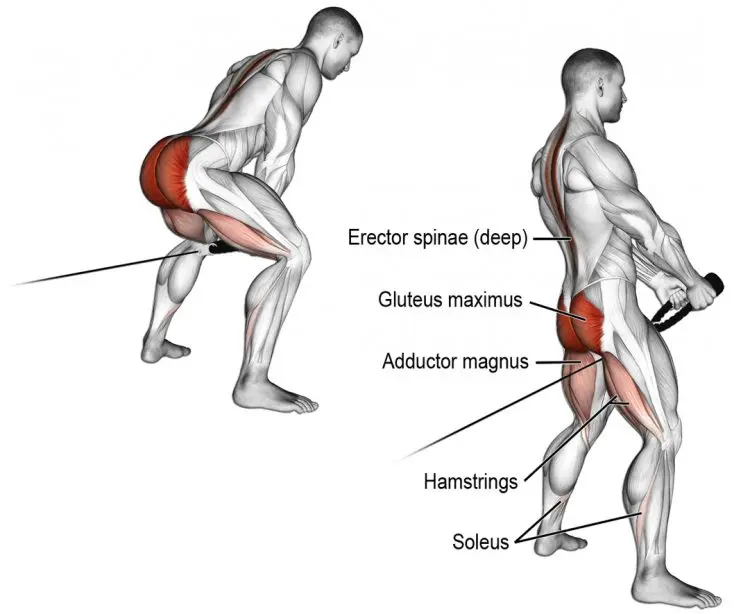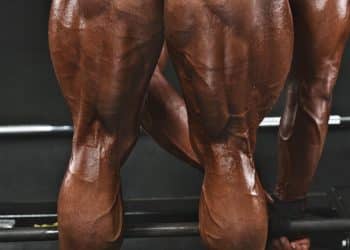From a functional perspective, your glutes, hamstrings, and lower back are probably the most important muscles in your body. Collectively, these muscles are often called your posterior chain.
Yes, your heart is THE most critical muscle, as it’s busy pumping blood around your body. But if you want to run faster, jump higher, lift heavier, or just look good in your jeans or bathing suit, the posterior chain is where it’s at.
There are lots of great posterior chain exercises to choose from, and they all offer benefits. But, if you are looking for a lower back-friendly exercise that’s easy to learn but also suitable for experienced lifters, look no further than cable pull throughs.
In this guide, we explain why and how to do cable pull throughs and reveal the seven best variations and alternatives.
Cable Pull Through – Muscles Worked
Cable pull throughs are a posterior chain exercise. That means they primarily work the muscles on the back of your body, and especially those around your hips. These muscles are your “engine room” and generate most of your lifting, running, and jumping power, which is why they’re so important.

The muscles that make up the posterior chain and are targeted by cable pull throughs are:
Level Up Your Fitness: Join our 💪 strong community in Fitness Volt Newsletter. Get daily inspiration, expert-backed workouts, nutrition tips, the latest in strength sports, and the support you need to reach your goals. Subscribe for free!
Gluteus Maximus
Known as the glutes for short and basically your butt, the gluteus maximus is the large muscle driving the powerful hip extension of cable pull throughs. Increase glute activation by contracting your butt as hard as you can at the top of each rep.
Hamstrings
Working with your glutes, your hamstrings also extend your hips. There are three muscles in the hamstring group; biceps femoris, semimembranosus, and semitendinosus. The hamstrings also flex your knees, i.e., when you do leg curls.
Erector Spinae
Running up both sides of your back, these muscles are responsible for extending your spine. In a lot of instances, including cable pull throughs, the erector spinae muscles contract isometrically to prevent spinal flexion.
Core
Core is the term used to describe the muscles that make up your midsection, including rectus abdominis, obliques, and transverse abdominis. These muscles work together to stabilize your spine and prevent your lower back rounding.
How to Do Cable Pull Throughs
Get more from cable pull throughs while minimizing your risk of injury by following these step-by-step instructions:
- Attach a rope handle to a low pulley machine. Stand with your back to the weight stack, feet astride the handle.
- With your abs braced and shoulders down and back, bend down and grab the handle with both hands. Stand up and take a couple of steps forward to tension the cable.
- Stand with your feet shoulder-width apart, knees slightly bent, hands in front of your hips. This is your starting position.
- Push your hips back and lean forward until you feel a deep stretch in your hamstrings. Keep going until your hands travel behind your knees. Do not allow your back to round. Maintain a neutral spine throughout, and that includes your upper back and neck.
- Drive your hips forward and stand back up, locking your knees and tensing your glutes as you reach the top of your rep.
- Hinge forward again and repeat.
You can also do pull throughs with straight legs, but this tends to deactivate your glutes, putting all the load on your hamstrings and lower back. As the hamstrings, glutes, and lower back usually work together, the bent-leg version is arguably the more functional choice.
Cable Pull Through Benefits and Drawbacks
Benefits
Still on the fence regarding cable pull throughs? Consider this list of benefits and then decide!
A GREAT posterior chain exercise – if you want to work your butt, hamstrings, and lower back, the cable pull through is a worthy option. There is lots of tension on the target muscles at the end of each rep, providing a very effective posterior chain workout. Whether you are a powerlifter, bodybuilder, or just want a better-looking rear-end, this exercise will help.
Lower back-friendly – cable pull throughs are one of the more lower back-friendly posterior chain exercises. The handle stays close to your center of gravity, which means you are less likely to round your back, especially compared to exercises like good mornings and straight leg deadlifts. It’s a viable option for exercisers with back pain, providing it’s okay with your doctor or physical therapist, of course!
Accessible – you should be able to do this exercise in most gyms. After all, the only things you need are a low cable machine, such as a cable crossover, and a rope handle. You can also do pull throughs using a resistance band.
Reinforce your hip hinge – the hip hinge is an essential skill for safer deadlifts, squats, kettlebell swings, and bent-over rows. The cable pull through provides a relatively safe way to practice and master the hip hinge.
Related: 6 Hip Hinge Exercises Guaranteed to Maximize Lower Body Power and Mobility
Easy to learn but still suitable for more advanced exercisers – compared to freeweight hip hinge exercises like kettlebell swings and Romanian deadlifts, cable pull throughs are easier to teach and learn. You can also start with a very low weight to master the hip hinge. However, and despite the ease of performance, the cable pull through can be done with very heavy weights, making it suitable for more experienced lifters.
Drawbacks
While cable pull throughs are a mostly beneficial exercise, there are also a few drawbacks to consider:
Level Up Your Fitness: Join our 💪 strong community in Fitness Volt Newsletter. Get daily inspiration, expert-backed workouts, nutrition tips, the latest in strength sports, and the support you need to reach your goals. Subscribe for free!
There is still a small chance of back injury – despite the short levers involved, it’s still possible to round your lower back during cable pull throughs. Poor flexibility, lack of core strength, and insufficient postural and positional awareness can lead to a flexed lumbar spine. If you find yourself rounding your lower back, stop your set and reduce the weight. You may also benefit from one of the more spine-friendly alternatives.
You need a cable machine – while any decent gym will probably have several cable machines, if you work out at home, you may not have the equipment you need to do cable pull throughs. The good news is that there are several alternatives you can use that work the same muscles, and you can also do pull throughs using a resistance band.
7 Cable Pull Through Variations and Alternatives
Cable pull throughs are a highly effective posterior chain exercise, but that doesn’t mean you need to do them all the time. There are several variations and alternatives you can use to keep your workouts productive and interesting:
1. Barbell Hip Thrust
The barbell hip thrust is another lumbar spine-friendly posterior chain exercise. While there is nothing wrong with the bodyweight variation of this move, which is a group exercise class staple, using a barbell will build and strengthen your posterior chain more effectively.
How to do it:
- Sit on the floor with your back against a stable bench and your legs bent, feet flat on the floor. Rest a barbell across your hips, using a folded gym mat for padding if required.
- Drive your feet into the floor and lift your hips up until they form a straight line with your knees and shoulders. Contract your glutes as hard as you can.
- Lower your hips back down to the floor and repeat.
2. Kettlebell Swing
The kettlebell swing and the cable pull through are very similar. The main difference is velocity, as swings are done much faster. This makes them better for improving muscle power, which is your ability to generate force quickly.
However, that speed is a double-edged sword, as moving faster tends to amplify technical issues like rounding your lumbar spine. Only do swings if you have mastered a slow and controlled hip hinge.
How to do it:
- Hold your kettlebell in front of your hips using an overhand grip. Stand with your feet about shoulder-width apart, toes turned slightly outward. Brace your core and pull your shoulders down and back.
- Bend your knees slightly, hinge forward from your hips, push your butt back, and lower the kettlebell down between your knees.
- Drive your hips forward and swing the kettlebell up to shoulder level. Keep your arms straight.
- Using your abs and lats, swing the kettlebell back down and hinge at your hips again.
- Transition immediately into another rep.
You can also start a set of kettlebell swings with the weight resting on the floor in front of your feet. Take hold of the handle, brace your abs, and then “hike” it back between your legs like a football. Try both methods to see which one works best for you.
3. Romanian Deadlift
Legend has it that this exercise came to the USA when American weightlifting coaches saw Romanian weightlifters doing it before an international competition. Whether that’s true or not, there is no denying the effectiveness of the RDL. Like cable pull throughs, this is a powerful posterior chain exercise. You can do it using a barbell or dumbbells as preferred. It’s also possible to do RDLs with a hex bar, which may be lower back-friendly.
Learn how to do Romanian deadlifts here.
4. Single-leg Romanian Deadlift
While there is nothing wrong with two-legged posterior chain exercises, a lot of the time, your legs work singularly, such as when you walk, run, kick, or throw. Because of that, it makes sense to include unilateral exercises in your lower body workouts.
The single-leg RDL is not just an effective glute and hamstring exercise; it’s also good for your mobility and balance. Whether you play sports or just want to develop better functional strength, this exercise will help.
Find out more about single-leg Romanian deadlifts here.
5. 45-Degree Back Extension
Also known as hyperextensions, the 45-degree back extension is a useful bodyweight posterior chain exercise. However, you can also make this exercise harder by holding dumbbells or weight in your hands or a barbell across your upper back.
How to do it:
- Climb onto the back-extension bench and place your feet flat on the footrests and your hips against the pads. Bend your knees slightly.
- Put your hands behind your back (easiest), across your chest (harder), or behind your head (hardest).
- Without rounding your lower back, hinge forward from your hips and lower your upper body down toward the floor as far as your flexibility allows.
- Drive your hips forward, contract your glutes and hamstrings, and bring yourself back up until your shoulders, hips, and knees form a straight line. Do NOT hyperextend your spine.
You can also do back extensions using a stability ball, which is a good option for home exercisers.
6. Stability Ball Hip Lift and Leg Curl
This bodyweight exercise combines two movements to really hammer your hammies and glutes. There is very little stress on your lower back, which could be beneficial for some exercisers.
How to do it:
- Lie on your back with your legs straight and feet resting on a stability ball. Place your hands on the floor by your side for balance.
- Push your heels into the ball to lift your butt off the floor so your body is straight.
- Next, bend your legs and curl the ball in toward you. Push your hips up to the ceiling as you roll the ball in.
- Push the ball away, so your legs are straight, and then lower your hips back down to the floor.
- That’s one rep – keep going!
7. Reverse Deficit Lunges
Lunges are often thought of as a quadriceps exercise. But, if you lunge backward, you’ll feel them more in your glutes and hamstrings. Yes, your quads ARE still involved, but to a lesser degree compared to forward lunges.
Using a deficit further increases glute and hamstring engagement by taking your hips through a more extended range of motion. Reverse lunges tend to be more knee-friendly than forward lunges, which is a bonus if you suffer from knee pain.
How to do it:
- Stand on a 6” platform with your feet together and arms by your sides. Use dumbbells if you wish.
- Take a large step back and, keeping your front shin and torso upright, bend your legs and lower your rear knee down to within an inch of the floor.
- Push off your back leg and bring your feet back together.
- Do all your reps with the same leading leg and then switch sides, or alternate legs rep by rep as preferred.
Wrapping Up
Whether you want “more junk in your trunk” or are trying to improve your running, squatting, or deadlift performance, cable pull throughs can help. Easy to learn but still suitable for strong, experienced exercisers, the cable pull through is one of those exercises that’s good for almost everybody’s body.
Use it as a preparatory exercise to fire up your glutes before your main workout or at the end as a posterior chain finisher. Start doing cable pull throughs a couple of times a week, and you’ll soon see and feel just how effective this exercise is.
Interested in measuring your progress? Check out our strength standards for Good Morning, Deadlift, Hip Extension, and more.








